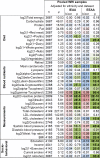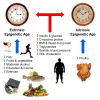Epigenetic clock analysis of diet, exercise, education, and lifestyle factors
- PMID: 28198702
- PMCID: PMC5361673
- DOI: 10.18632/aging.101168
Epigenetic clock analysis of diet, exercise, education, and lifestyle factors
Abstract
Behavioral and lifestyle factors have been shown to relate to a number of health-related outcomes, yet there is a need for studies that examine their relationship to molecular aging rates. Toward this end, we use recent epigenetic biomarkers of age that have previously been shown to predict all-cause mortality, chronic conditions, and age-related functional decline. We analyze cross-sectional data from 4,173 postmenopausal female participants from the Women's Health Initiative, as well as 402 male and female participants from the Italian cohort study, Invecchiare nel Chianti.Extrinsic epigenetic age acceleration (EEAA) exhibits significant associations with fish intake (p=0.02), moderate alcohol consumption (p=0.01), education (p=3x10-5), BMI (p=0.01), and blood carotenoid levels (p=1x10-5)-an indicator of fruit and vegetable consumption, whereas intrinsic epigenetic age acceleration (IEAA) is associated with poultry intake (p=0.03) and BMI (p=0.05). Both EEAA and IEAA were also found to relate to indicators of metabolic syndrome, which appear to mediate their associations with BMI. Metformin-the first-line medication for the treatment of type 2 diabetes-does not delay epigenetic aging in this observational study. Finally, longitudinal data suggests that an increase in BMI is associated with increase in both EEAA and IEAA.Overall, the epigenetic age analysis of blood confirms the conventional wisdom regarding the benefits of eating a high plant diet with lean meats, moderate alcohol consumption, physical activity, and education, as well as the health risks of obesity and metabolic syndrome.
Keywords: DNA methylation; aging; alcohol intake; diet; epigenetic clock; fish intake; lifestyle.
Conflict of interest statement
The Regents of the University of California is the sole owner of a provisional patent application directed at the invention of measures of epigenetic age acceleration for which SH is a named inventor. The other authors declare no conflict of interest.
Figures




References
Publication types
MeSH terms
Grants and funding
- HHSN268201100001I/HL/NHLBI NIH HHS/United States
- R01 ES025225/ES/NIEHS NIH HHS/United States
- R01 ES020836/ES/NIEHS NIH HHS/United States
- HHSN268201100004I/HL/NHLBI NIH HHS/United States
- HHSN268201100046C/HL/NHLBI NIH HHS/United States
- T32 NS048004/NS/NINDS NIH HHS/United States
- HHSN268201100003C/WH/WHI NIH HHS/United States
- P30 CA060553/CA/NCI NIH HHS/United States
- HHSN271201100004C/AG/NIA NIH HHS/United States
- HHSN268201100002C/WH/WHI NIH HHS/United States
- HHSN268201100003I/HL/NHLBI NIH HHS/United States
- HHSN268201100002I/HL/NHLBI NIH HHS/United States
- U34 AG051425/AG/NIA NIH HHS/United States
- R01 AG042511/AG/NIA NIH HHS/United States
- HHSN268201100001C/WH/WHI NIH HHS/United States
- HHSN268201100004C/WH/WHI NIH HHS/United States
- P30 ES009089/ES/NIEHS NIH HHS/United States
- R01 MD009164/MD/NIMHD NIH HHS/United States
- R01 ES021733/ES/NIEHS NIH HHS/United States
LinkOut - more resources
Full Text Sources
Other Literature Sources
Medical

